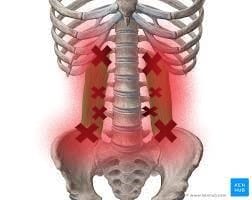Unfortunately, there is a great misunderstanding by most health professionals when it comes to chronic back pain with most still operating under the very outdated belief that pain is due to hips being out, disc degeneration, tight hip flexors, a weak core, etc… In my opinion, this is why when large, high-quality studies are done looking at these treatments compared to placebo or no treatment the effects on chronic low back pain are moderate & short-term. Recently I did a seminar on a physiotherapy-led approach called cognitive functional therapy, which looks at the interplay between pain, how it affects function and the role of how we perceive and think about pain has on outcomes, pain can be complex especially if it has become chronic/persistent (over 3 months) and is affecting daily activities, exercise, sleep, mood levels, etc…
You can listen to a 10-minute interview on ABC radio with Professor Peter O’Sullivan about cognitive functional therapy and the results they got when they did a large study comparing to standard care i.e., chiro, physio, massage, etc… with this new approach. Although this study looked at chronic back pain with an average of 4 years duration, it can also be helpful with back pain of different duration and can potentially help people avoid chronic back pain in the first place! https://www.abc.net.au/radionational/programs/breakfast/new-treatment-offers-hope-for-people-with-chronic-back-pain/102294734
Pain equals damage.
Most people with back pain develop it over time, and there is no one particular incident or event that leads to experiencing back pain. Due to day-to-activates the spine particularly the muscles and joints may get painful and sensitive. Pain may be exacerbated by stress, tension, poor sleep, obesity, lack of exercise, fear-avoidant behaviors which may prolong recovery. If pain was simply due to tissue damage, just like spraining an ankle or a cut on the skin the body will heal itself.
Alignment does not equal back pain.
There is not a day that goes by I treat someone with neck pain and have no history of back pain despite having a pelvic misalignment, short leg, scoliosis, pelvic tilt, etc… There are just as many people with “misalignments” without backpain than those with misalignments and backpain. There’s a reason why people who get treatment for “alignment” often get short-term results and constantly need to go back for “realignment”. In fact many high volume business models in chiropractic will use alignment as a marketing tool, its much more financially beneficial to treat someone for 10 minutes, potentially seeing up to 6 people an hour and see them multiple times a week and regularly for months to “realign” them, I call these chiropractors “whack, crack & keep em comin back chiropractors”. It’s a business model and not healthcare.
It’s also worth noting the cracking sound is gas being released from the fluid within your joints, it has nothing to do with bones going back into place. I’m not sure how many pain sufferers would be willing to pay $80-$90 for a 10 minute treatment if it wasn’t to supposedly have their spine realigned, neck curve restored, hips put back in.
Low back pain is rarely serious
Less than 5% of people who have back pain are due to a serious or medical condition such as cancer, trauma, infection, autoimmune/inflammatory arthritis, etc… Having said that it’s still important to screen for such things as part of a routine back pain assessment done by your chiropractor or physiotherapist.
Your back pain is due to “old age”.
Research shows back pain peaks in the age group 45-50 years and then declines thereafter as shown in this graph. Interestingly you can also see the prevalence of back pain has only increased from 1990-2015, clearly how we view back pain and treat it as health providers leaves a lot to be desired.
Pain on movement means you’re damaging your spine.
It’s normal to feel pain on movement when you first experience back pain, this typically comes from the muscles in and around your spine either guarding and trying to protect the area. It’s a normal process and doesn’t represent damage, your muscles and nervous system are generally more sensitive to movement, and the quicker you can get out of pain with good treatment on the spasmed and guarding muscles and reintegrating movement with exercise and graded exposure to painful movement the faster the recovery will likely be.
Scans & X-rays rarely show the cause of back pain.
I have written an article on this particular topic, you can read it here. Not only are scans notoriously bad at diagnosing most back pain, but they actually cause people to become dependent on passive and ineffective therapy and can actually make pain worse!
Posture is not related to low back pain.
Although we may feel pain when sitting, standing, and bending these are rarely the cause of back pain. Rather than focusing on posture, focus on getting a variety of movements and changes in postures throughout the day, if you were to sit with “good posture” all day this is unlikely to change the levels of pain you experience, in fact, it may make it worse as you are tensing the spinal muscles to maintain an upright and rigid posture. Also, avoid treatments that over empathise posture, just like alignment these therapies tend to get very short term results with chronic pain.
A weak core does not cause back pain
Research shows the exercise you do is not that important, getting regular exercise is important as opposed to just strengthening the core, some people will brace and hold their core muscles when it’s usually best to relax the muscles and spine. It’s worth mentioning most people get their back pain when sitting, first thing in the morning, when stressed, tying shoe laces, mundane activities etc… despite these activities having minimal to no core requirements.
You need long term/extensive treatment for back pain.
As you can see, most back pain is not dangerous or a result of your spine being “broken”, you do not need extensive or long-term therapy, and the only people who benefit are the ones who are financially invested in getting you back repeat visits and lifelong treatment. Unfortunately there are greedy and unethical providers who will create more fear and anxiety around your pain to get you dependent on their extensive treatments.
Pain flare up do not equal more damage.
Although pain flare-ups or acute pain can be very painful and distressing it is not a good indication of damage, the bark is almost always more than the bite when it comes to acute back pain. The majority of the time it is an intense spasm of the spinal muscles. Just like having a calf cramp/spasm can be extremely painful it is usually innocuous and self-limiting.


